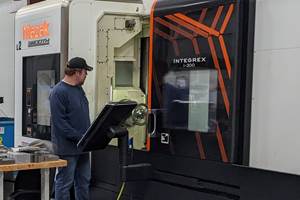Tips: How to Develop an Internal Blog
Setting up an internal blog is easy to do.  Here are steps for getting your blog going and topic ideas that have been valuable for others.
Share





With today’s software options (and many free), the technical aspects of setting up an internal blog are fairly easy.  The planning of your blog topics and use of it among your colleagues are the most important step to setting up an internal blog for your group.  
A blog is simply a conversation among a common group of people (community) about a particular topic.  In the case of your company’s manufacturing engineers and shop-floor personnel, an internal blog may allow you to leverage the knowledge and ideas of a group when you are physically dispersed or have difficulty seeing each other often.  It’s a new gathering place, another coffee-pot moment or simply a quick and easy way to communicate or banter about work issues or ideas.
Here are steps you should take to get an internal blog setup for your group.
              a. What purpose does the blog serve? What do you want it to impact?
              b. What are you going to write about? Be fairly specific.
              c. Who will champion the blog and serve as primary writer?
              d. Who will likely read it and/or participate? 
ŐżŐżŐżŐż2.Őż Choose Your Software.¬† There are many free software packages available today along with some low-price options also.¬† Two types of blog software include hosted or self-hosted. A hosted blog is software that resides on an outside server. This is not recommended for an internal blog. Self-hosted software is downloaded and installed on your internal server. Both types offer features that make them easy to install and easy to use.¬† Some popular software names include Blogger, WordPress, Movable Type, and TypePad.
ŐżŐżŐżŐż3.Őż Create A ‚ÄúLook.‚Ä̬† Apply a look or skin that matches the tone of the community it will serve.¬† Not only does this provide a comfortable meeting place, but it¬† helps communicate the relevancy of the topic before members read or post to it.
ŐżŐżŐżŐż4.Őż Relax And Write.¬† Writing for a blog is just like a conversation. Keep it casual, lighthearted, funny, and lightly edited.¬† Most importantly, create content that is worth reading and comes from you.¬† Inspire others to respond and continue the dialogue.
ŐżŐżŐżŐż5.Őż Keep It Real.¬† Share facts and insights with openness.¬† This is not a place to spout one-way lectures, instructions, or hard views.¬† Respect the opinions and ideas of others. ¬†
ŐżŐżŐżŐż6.Őż Lose Control.¬† Let your blog conversation evolve naturally.¬† Avoid controlling the dialogue.¬† If the topic has run its course, let it die naturally. ¬†
ŐżŐżŐżŐż7.Őż Connect It.¬† Link your blog to related content.¬† If you have a centralized project center, hook it up.¬† If you have design documents, production schedules, drawings, or other online files that are related to the topic, hook it up.¬† Easy access to all related resources will¬† help make it more valuable and inspire more conversation.
Now that you have some guidelines for setting up an internal blog, what types of topics might be effective for your community or teams?
Project Blogs ‚Äď Attach the blog discussion to a project or product line, depending upon how you structure your workflow.¬† Use the blog to communicate changes as well as reasons for the changes.¬† Allow others to comment and share perspectives.
Problem-Solving Blogs ‚Äď Create a blog that address a technical issue that has become a common or hard-to-solve problem.¬† Maybe a colleague in another location or on another shift has information, ideas, or solutions that may help lead to a quick and impactful solution.
Lessons Learned Blogs ‚Äď Set up up a blog that details how a difficult problem was solved.¬† Capture creative approaches and best practices, and be sure to include what didn‚Äôt work too.¬† These exchanges become very valuable to reduce rework and also to leverage what you already know for future projects and product challenges.
Equipment Evaluation Blogs ‚Äď Have you worked with various tooling options, new machines or new processes?¬† What equipment has worked best on particular types of materials?¬† Share your experiences using various types of equipment and suppliers with your peers as you are evaluating customer needs or improving your operations.
Give it try.  Often the best solutions and ideas are found in casual conversations. So long as you are respectful and offer valuable content, you can’t fail or annoy anyone too much.  And blogging can be a lot of fun too.
Related Content
ERP Captures Process Know-How Before it Retires
As shops struggle to overcome the skills gap, ERP systems can improve the onboarding process and help document processes as skilled workers retire.
Read More5 Tips for Running a Profitable Aerospace Shop
Aerospace machining is a demanding and competitive sector of manufacturing, but this shop demonstrates five ways to find aerospace success.
Read MoreHow a Custom ERP System Drives Automation in Large-Format Machining
Part of Major Tool’s 52,000 square-foot building expansion includes the installation of this new Waldrich Coburg Taurus 30 vertical machining center.
Read MoreRefining Shopfloor Processes for Mission-Critical Parts
Pacon Mfg, Inc. has not rested on its laurels as the 2020 Top Shop Honoree for Shopfloor Practices and Performance. In the years since, it has refined its processes to continue excelling in a volatile market.
Read MoreRead Next
AMRs Are Moving Into Manufacturing: 4 Considerations for Implementation
AMRs can provide a flexible, easy-to-use automation platform so long as manufacturers choose a suitable task and prepare their facilities.
Read MoreMachine Shop MBA
Making Chips and 91 ”∆ĶÕÝ’ĺőŘ are teaming up for a new podcast series called Machine Shop MBA—designed to help manufacturers measure their success against the industry’s best. Through the lens of the Top Shops benchmarking program, the series explores the KPIs that set high-performing shops apart, from machine utilization and first-pass yield to employee engagement and revenue per employee.
Read More

















